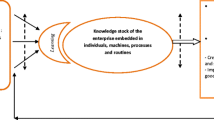Abstract
Knowledge-based economies use knowledge as an input of production to produce knowledge-intensive products and services. In such economies, a firm’s growth crucially depends on knowledge accumulation, technical change and the resulting innovation activities. To achieve sustained growth, a firm must keep on innovating. A firm’s core competence and its refinement and development over time play a crucial role in a firm’s innovation activities and its growth. In this paper, a conceptual framework of a firm’s innovation and growth in knowledge-based economy is presented. This framework is based on a firm’s core competence and its development over time within a firms’ cluster. This model is empirically estimated and evaluated, in a pilot study, via a data set from a manufacturing cluster of 128 firms operating in the North East England. The empirical results provide some support for the proposed framework. In particular, it is found that the conditional probability that a firm undertakes R&D activity to innovate in such a cluster of firms is over 70 %.


Similar content being viewed by others
References
Antonelli, C. (2001). The microeconomics of technological systems. Oxford: Oxford University Press.
Barney, J., & Hostelry, W. S. (2009). Strategic management and competitive advantage: concepts and cases (3rd edn). Upper Saddle River: Prentice Hall.
Brinkley, I (2006) Defining knowledge economy. Knowledge economy programme report. The Work Foundation, London
Brnysonsson, J., & Hitt, R. (2003). Computing productivity: firm level evidence. Cambridge: MIT.
Child, J., & Faulkener, D. (1998). Strategies of co-operation. Oxford: Oxford University Press.
Collis, D. (1996). Organisational learning and comparative advantage. London: Sage.
Combes, P., & Overman, M. (2004). The spatial distribution of economic activities in the European Union. In V. Henderson & J. F. Thissee (Eds.), Handbook of urban and regional economics. Amsterdam: Elsevier-North Holland.
Combs, R. (1996). Core competencies and the strategic management of R&D. R&D Management, 26(4), 345–355.
Comin, D. (2004). R&D: a small contribution to growth. Journal of Economic Growth, 2(3), 34–45.
De Wit, B., & Meyer, R. (2010). Strategy process, content, context: an international perspective (4th ed.). Andover: South-Western Cengage Learning.
Dixon, A. J., & Seddighi, H. R. (1996). An analysis of R&D activities in North East England manufacturing firms: the results of a sample survey. Regional Studies, 30(3), 287–294.
Drejer, A. (2001). How can we define and understand competencies and their development? Technovation, 21(3), 135–146.
Grant, R. (1996). Towards a knowledge-based theory of the firm. Strategic Management Journal, 17, 109–122. Winter special issue.
Griliches, Z. (1991). The search for R&D spillovers. NBER Working Paper, No. 3768.
Grossmann, G. M., & Helpman, E. (1991). Innovation and growth in the global economy. Cambridge: MIT.
Hill, E. W., & Brennan, J. F. (2000). A methodology for identifying the drivers of industrial clusters: the foundation of regional competitive advantage. Economic Development Quarterly, 14(1), 65–96.
Jaffe, A. (1986). Technological opportunity and spillovers from R&D: evidence from firms' patents, profits and market value. American Economic Review, 76, 984–1001.
Jaffe, A., Trajtenberg, M., & Henderson, R. (1993). Geographic localisation of knowledge spillovers as evidenced by patent citations. Quarterly Journal of Economics, 108, 577–598.
Johnson, G., Whittington, R., & Scholes, K. (2011). Exploring strategy: texts and cases (9th ed.). London: Prentice Hall.
Malerba, F. (1992). Learning by firms and incremental technical change. The Economic Journal, 102, 845–859.
Nelson, R. (1993). National systems of innovation. Oxford: Oxford University Press.
Porter, M. E. (1981). The contributions of industrial organization to strategic management. Academy of Management Review, 6, 609–620.
Porter, M. E. (2000). Location, competition, and economic development: local clusters in a global economy. Economic Development Quarterly, 14(1), 15–34.
Prahalad, C., & Hamel, G. (1990). The core competence of the corporation. Harvard Business Review, 68(3), 79–88.
Reay, P., & Seddighi, H. R. (2012). An empirical evaluation of management and operational capabilities for innovation via co-creation. European Journal of Innovation Management, 15(2), 259–275.
Romer, P. M. (1990). Endogenous technical change. Journal of Political Economy, 98, 71–102.
Schmitz, H. (2000). Does local co-operation matter? Evidence from industrial clusters in South Asia and Latin America. Oxford Development Studies, 28(3), 323–338.
Seddighi, H. R. (2012). Introductory econometrics: a practical approach. London: Routledge.
Seddighi, H. R., & Huntley, P. (2007). R&D activities in a peripheral region: an empirical study with special reference to the North East region of the UK. Economics of Innovation and New Technology, 16(3), 211–225.
Seddighi, H. R., Nutall, M. W., Evans, J., & Lawler, K. A. (2002). R&D activities and firms characteristics: some evidence from North East England. Global Business & Economics Review, 4(2), 261–276.
Solow, R. M. (1957). Technical change and the aggregate production function. The Review of Economics and Statistics, 39, 312–320.
Suekum, J., & Bline, W. (2005). Local economic structure and industry development in Germany, 1993–2001. Economic Bulletin, 15(N0.17), 1–18.
Swann, P., & Prevezer, M. (1996). A comparison of the dynamics of industrial clustering in computing and biotechnology. Research Policy, 25, 1139–1157.
Thomas, H., & Pollock, T. (1999). From I-O Economics’ S-C-P paradigm through strategic groups to competence-based competition: reflections on the puzzle of competitive strategy. British Journal of Management, 10, 127–140.
Author information
Authors and Affiliations
Corresponding author
Rights and permissions
About this article
Cite this article
Seddighi, H.R. A Model of a Firm’s Innovation and Growth in a Knowledge-Based Economy. J Knowl Econ 6, 215–227 (2015). https://doi.org/10.1007/s13132-012-0136-1
Received:
Accepted:
Published:
Issue Date:
DOI: https://doi.org/10.1007/s13132-012-0136-1




